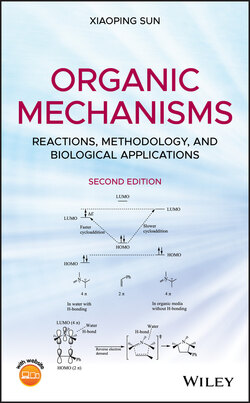Читать книгу Organic Mechanisms - Xiaoping Sun - Страница 22
1.5 THERMODYNAMICS 1.5.1 Enthalpy, Entropy, and Free Energy
ОглавлениеEnthalpy (H), entropy (S), and free energy (G) are all thermodynamic state functions. Enthalpy (H) is defined as the sum of internal energy (U) and the product of pressure (P) and volume (V), formulated as
(1.45)
From Equation 1.45, the change in enthalpy (ΔH) can be calculated as
(1.46)
At constant pressure (P), Equation 1.46 becomes
According to the first law of thermodynamics, qP = ΔU − w (heat).
Therefore,
(1.47)
The physical meaning of Equation 1.47 is that the enthalpy change in a process (including a chemical reaction) at constant pressure is equal to the heat evolved. Since most of the organic reactions are conducted at constant pressure, the reaction heat can be calculated on the basis of the enthalpy change for the reaction.
Entropy (S) is considered as the degree of disorder. In thermodynamics, the infinitesimal change in entropy (dS) is defined as the reversible heat (dqrev) divided by the absolute temperature (T), formulated as
For a finite change in state,
(1.48)
Free energy (G) is defined as
At constant temperature and pressure, the change in free energy (ΔG) can be calculated as
(1.49)
